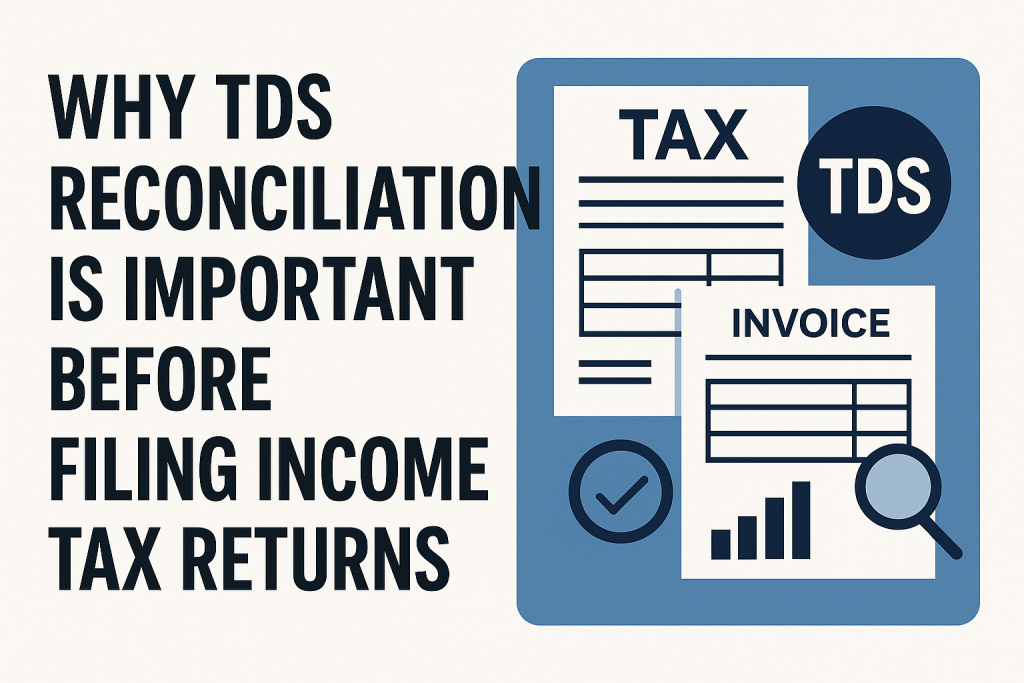Why TDS Reconciliation Is Important Before Filing Income Tax Returns
Filing your Income Tax Return (ITR) is one of the most important financial responsibilities of every taxpayer. While many focus on gathering documents and calculating income, a critical yet often overlooked step is TDS reconciliation. Ensuring that the tax deducted at source (TDS) has been correctly reported, recorded, and credited is essential to avoid errors, rejections, and future complications.
This blog explains what TDS reconciliation is, why it is crucial, and how you can do it properly to ensure accurate tax filing and avoid notices, penalties, or delays in refunds.
What is TDS Reconciliation?
TDS (Tax Deducted at Source) reconciliation is the process of matching the tax deducted and reported by various deductors (such as employers, banks, clients, etc.) with the actual TDS entries reflecting in:
- Form 26AS – the Tax Credit Statement,
- AIS (Annual Information Statement) – a more comprehensive financial transaction report, and
- Your own income and TDS certificates (Form 16, Form 16A).
The goal is to ensure that all TDS deducted on your behalf is correctly credited to your PAN and matches the amount you claim in your ITR.
What is AIS (Annual Information Statement)?
The AIS is an enhanced financial statement introduced by the Income Tax Department that includes:
- Details of TDS/TCS,
- Interest income, dividends, securities and mutual fund transactions,
- Foreign remittances, property purchases, and other high-value transactions.
This is a powerful tool that complements Form 26AS by offering a 360-degree view of your financial activities.
Why is TDS Reconciliation Important Before Filing ITR?
- Avoid Rejection or Delay of Your Income Tax Return
If there is a mismatch between the TDS you claim in your ITR and what is reflected in Form 26AS or AIS, the return may be rejected or flagged for verification. Reconciliation ensures all figures match, making your return error-free and easier to process.
- Ensure You Get Full Tax Credit
TDS deducted by employers, banks, or clients must be correctly credited to your PAN. If not reconciled, you may miss out on claiming TDS already deducted, resulting in higher tax liability or reduced refunds.
- Identify Errors in TDS Reporting
Deductors may make errors such as quoting the wrong PAN, reporting incorrect TDS amounts, or not filing TDS returns on time. Reconciliation helps you detect such discrepancies early, so you can request the deductor to correct them through a revised TDS return.
- Prevent Tax Notices and Scrutiny
A common cause for Income Tax notices is mismatched or under-reported income. When your ITR doesn’t align with AIS or 26AS, it raises red flags. Timely reconciliation helps you stay compliant and avoid unnecessary legal hassles or penalties.
- Speed Up Refund Process
If you’re expecting a refund, proper reconciliation ensures that the TDS reflected in the system matches your claim. This significantly reduces the chances of your refund being withheld for verification, ensuring faster and smoother processing.
- Accurate Income Disclosure
AIS captures various income sources such as interest from savings accounts, dividends, rent, and capital gains. Reconciling these figures with your records ensures that no income is under-reported, protecting you from penalties for concealment.
- Compliance and Peace of Mind
By reconciling TDS, you ensure all third-party information reported to the Income Tax Department is fully reflected in your return. This ensures full compliance with the law and gives you confidence in the accuracy of your ITR.
How to Reconcile TDS Before Filing Your ITR
Follow these steps for a thorough TDS reconciliation:
1. Download Form 26AS
- Log in to the Income Tax e-Filing Portal.
- Go to “e-File” → “Income Tax Returns” → “View Form 26AS”.
- Select the relevant financial year and download the statement.
2. Download AIS (Annual Information Statement)
- Visit https://www.incometax.gov.in
- Log in using PAN, password, and captcha.
- Go to the ‘Services’ tab → Click on ‘Annual Information Statement (AIS)’.
- Select the financial year and download AIS in PDF or JSON format.
- PDF Password: PAN (uppercase) + Date of Birth (DDMMYYYY).
3. Collect all TDS Certificates
- Obtain Form 16 (from employer) and Form 16A (from banks, clients, etc.).
4. Match the Details
- Compare the TDS amount, TAN of deductor, and other information across:
- Form 26AS
- AIS
- Your TDS Certificates and income records
5. Resolve Mismatches (if any)
- Contact the deductor for corrections if any errors or omissions are found.
- Request a revised TDS return to ensure it reflects correctly in 26AS.
6. File ITR Using Reconciled Figures
- Only after confirming the accuracy of TDS entries, proceed with ITR filing.
Conclusion
TDS reconciliation is a simple but powerful step that can prevent major tax-filing errors, help you get your rightful tax credit, and keep you compliant with the Income Tax laws. Whether you’re salaried, self-employed, or a business owner, always reconcile your TDS, 26AS, and AIS before filing your return.
Taking the time to review and match your tax data not only helps you file your ITR accurately but also gives you peace of mind knowing there’s nothing missed that could trigger scrutiny or delay your refund.




